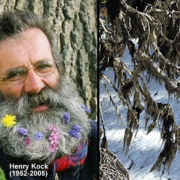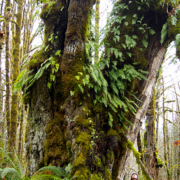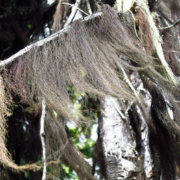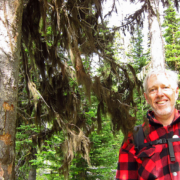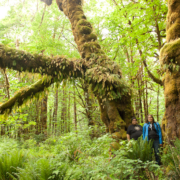The Land Conservancy and Ancient Forest Alliance are hoping to bank in on lichens.
After discovering two new lichen species in the southern Interior, lichenoligist Trevor Goward decided to donate the naming rights to raise money for conservation causes.
He passed on the naming rights to be auctioned off to help TLC and the AFA. The deadline for both auctions is Dec. 15.
When biologist Andy McKinnon, from Metchosin, heard his friend Goward, of 30 years, discovered two new lichen species, he was thrilled and bid $3,000 on each auction. But he has been out bid on both. Currently the bids are sitting at $3,500 and $6,000.
“I would love this to attract some major efforts to donate to the cause,” Goward said. “At the moment the bids are absurdly low.”
The money raised for TLC will go towards purchasing a land corridor between two pieces of Wells Grey Park in the southern Interior of B.C.
“We want to create a corridor for the wilderness to cross through,” said TLC northern region manager Barry Booth. He explained currently the wildlife such as grizzly bears and moose already cross through the area which is currently privately owned.
For this project TLC needs to raise more than $350,000.
This project hits close to home for Goward who donated 10-acres of property within the corridor. His neighbour has also donated 62 acres of his property to the cause. Now to secure the corridor TLC needs to purchase an additional 28 acres.
“As the place gets built up (and developed) the animals still need to get from one place to another,” Goward said explaining one side of the park is where the animals spend the winter and the other is their summer range.
The AFA doesn’t have a specific project it will use the money on but has several projects in the works, said Ken Wu AFA executive director.
“A lot of lichens grow in old growth forests, when those forests are gone the lichen will disappear,” Goward said. “I’ve been watching these places disappear my whole life. I feel (the AFA) will make a difference. ”
Some of the projects where the money could be used include, creating a series of educational brochures, covering travel expenses to focus on other areas of B.C., and to help build a campaign in swing ridings across the province to help protect old-growth forests.
Other than raising awareness for the AFA, Wu said he hopes this type of auction gains attention and sparks up other auctions across the world for conservation efforts.
“This is a model. If it’s successful it can stimulate other campaigns,” Wu said.
While the auction is designed to help both conservation groups, it can also make the winning bidder remembered forever.
“The point is you could name it parmelia charlaensis,” McKinnon said siting my name. “This is one of the very few ways you can achieve immortality. If you truly love someone you can immortalize them.”
As an example McKinnon sited Archibald Menzie.
The Douglas fir tree’s scientific name is pseudotsuga menziesii. It was named after Archibald Menzie, who was appointed to be the surgeon and naturalist on the world trip with Captain George Vancouver.
“Today we look at that tree and we remember Archibald Menzie,” said McKinnon. “If you name the lichen 200 years later people will think of you.”
There are already lichens named after Barrack Obama and Sponge Bob Square Pants.
The option for naming the two species is limitless and McKinnon explained it’s open to anyone, including businesses.
“You could name it after a business, you could call it bryoria Wal-Martia,” McKinnon said.
Of the two lichens discovered, one was is bryoria and one is a parmelia.
“The bryoria looks like lustrous brown hair,” McKinnon said adding it is very shiny and can grow up to 10 inches long. “The parmelia looks more like a leaf and is reddish brown.”
Bryoria lichens are a common winter food for the endangered mountain caribou among other animals.
“Without bryoria lichens the mountain caribou would disappear form B.C. and possibly this earth,” McKinnon said.
The parmelia lichens are commonly used as dye for tweed fabrics. Hummingbirds also use it to disguise their nests.
“Lichens are not an organism, it’s a couple living together,” McKinnon said explaining a lichen is made up of about 95 per cent fungus and five per cent alga.
Alga is plant similar to seaweed. It lives inside the fungus and provides the food for the fungus to grow.
“Together they live happily ever after,” McKinnon said.
Goward wants people to step up and help him in is conservation efforts.
“Take a look at Google earth and see what we’ve done,” Goward said.
“In the end it doesn’t matter (about the names) we want to raise funds for habitats for lichens and everything else that lives in the B.C. wildlife places,” McKinnon said.
To bid on the TLC auction call 1-877-485-2422. To place a bid through the Ancient Forest Alliance email info@16.52.162.165 or call 250-896-4007. The deadline is Dec. 15.
[Original Goldstream News Gazette article no longer available]

